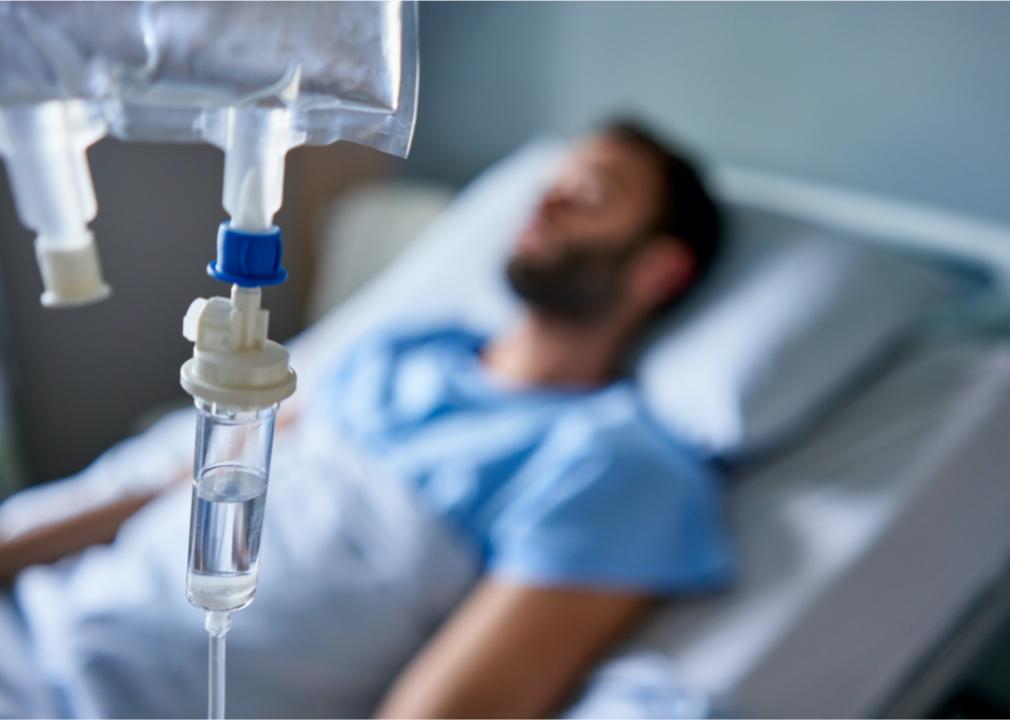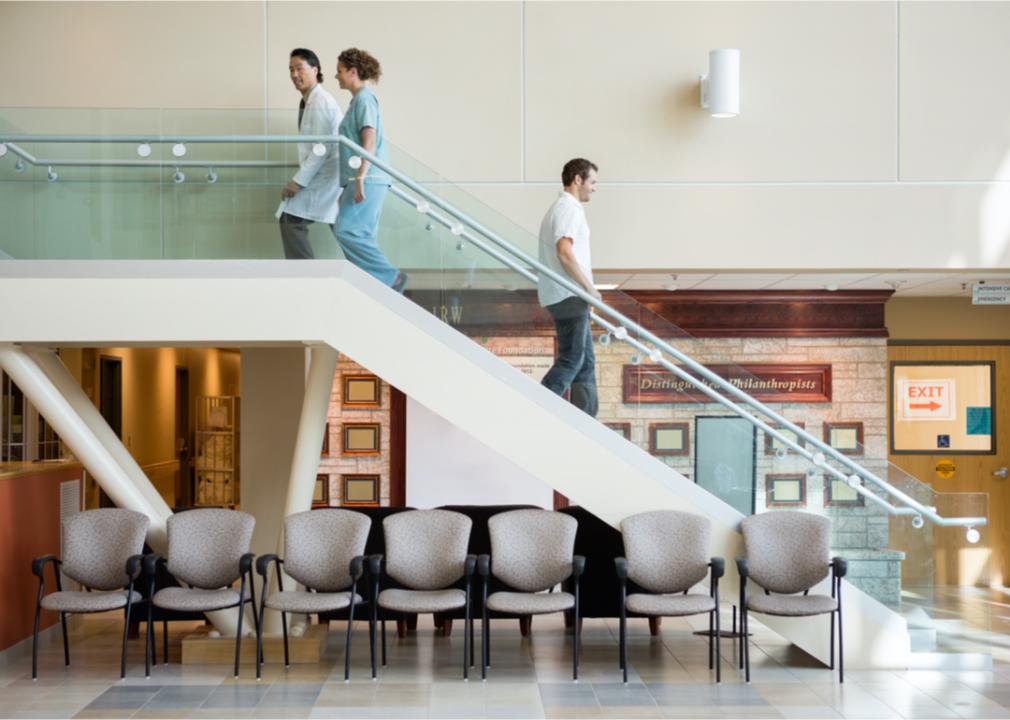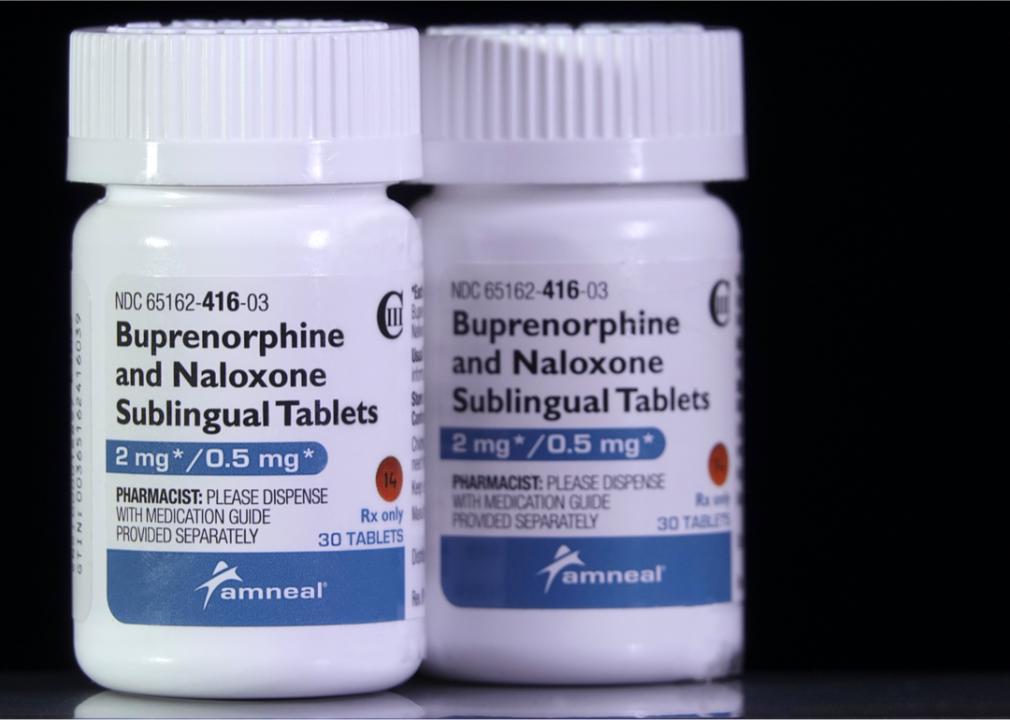Most common types of care at America’s 16,000-plus drug treatment facilities

Photographee.eu // Shutterstock
Most common types of care at America’s 16,000-plus drug treatment facilities
As opioids wreak havoc on thousands of lives, drug treatment facilities are becoming increasingly vital to communities. In 2021, drug overdose deaths breached more than 100,000, and the numbers keep climbing. According to the Center for Disease Control and Prevention, this was a 28.5% increase from the number of overdose deaths the year before.
Unfortunately, for some, treatment can be difficult to receive. Many Americans face racial disparities, particularly Black, Latino, and Native Americans. Other roadblocks include cost, insurance coverage, and the social stigma surrounding addiction.
For those that are struggling with addiction, there is a wide variety of types of treatment as well as types of facilities. For U.S. military veterans, you may enter into programs run by the Department of Veteran Affairs, and for Native Americans, tribal government and Indian Health Service facilities are available. There are also private nonprofit and for-profit organizations that offer treatment.
Each type of drug treatment center offers various types of care and programs for patients. This can range from inpatient hospitalization to regular outpatient care.
Citing data from the National Survey of Substance Abuse Treatment Services (SAMHSA), Zinnia Health broke down the 10 most common types of care in the United States’ substance use recovery centers.
![]()

Guschenkova // Shutterstock
#10. Hospital inpatient treatment
– Available at 658 facilities
— 3.2% of private non-profit facilities (255)
— 4.7% of private for-profit facilities (306)
— 3.6% of local, county, or community govt. facilities (24)
— 12.7% of federal government facilities (41)
— 11.2% of state government facilities (32)
— 0.0% of tribal government facilities (0)
— 16.7% of Dept. of Veterans Affairs facilities (38)
— 3.5% of Dept. of Defense facilities (2)
— 0.0% of Indian Health Service facilities (0)
In 2020, out of the 16,066 facilities, hospital inpatient treatment was available at 658 facilities. Hospital inpatient treatment requires those with substance use disorders (SUD) or alcohol use disorder (AUD) reside at the care facility for a certain length of time depending on the program. Despite being one of the most effective forms of treatment at substance use recovery centers in the U.S., this was also the least available. In fact, this form of treatment is nonexistent at tribal government or Indian Health Service facilities, according to data from SAMHSA. This may be because this can be one of the most expensive forms of treatment. Inpatient treatment can cost $500 to $650 a day, and if you’re enrolled in a 30-day program, that treatment can cost you anywhere from $15,000 to $19,500.

marvent // Shutterstock
#9. Hospital detox care
– Available at 784 facilities
— 3.9% of private non-profit facilities (312)
— 5.3% of private for-profit facilities (344)
— 4.5% of local, county, or community govt. facilities (30)
— 22.0% of federal government facilities (71)
— 8.8% of state government facilities (25)
— 0.8% of tribal government facilities (2)
— 29.8% of Dept. of Veterans Affairs facilities (68)
— 3.5% of Dept. of Defense facilities (2)
— 0.0% of Indian Health Service facilities (0)
Similar to inpatient treatment, hospital detox care is both one of the least common and most expensive forms of treatment for addiction. This method of care is available at 784 facilities, mostly at private nonprofit or private for-profit facilities. No hospital detox care programs were available at Indian Health Services facilities. Hospital detox care is a program where patients go through detoxification from addictive substances and are overseen by hospital staff. On a daily basis, medical detox can cost between $500 to $650 which, like with hospital inpatient treatment, can be a difficult financial hurdle for many people to surpass. This type of care is especially in demand in the Northeast region of the U.S. in states such as New Jersey, where centers report addiction to be a growing issue as a result of the impact of the COVID-19 pandemic.

Tyler Olson // Shutterstock
#8. Residential detox care (non-hospital)
– Available at 784 facilities
— 3.9% of private non-profit facilities (312)
— 5.3% of private for-profit facilities (344)
— 4.5% of local, county, or community govt. facilities (30)
— 22.0% of federal government facilities (71)
— 8.8% of state government facilities (25)
— 0.8% of tribal government facilities (2)
— 29.8% of Dept. of Veterans Affairs facilities (68)
— 3.5% of Dept. of Defense facilities (2)
— 0.0% of Indian Health Service facilities (0)
Residential detox care was found to be available at 1,412 facilities across the U.S. While this type of care is not offered in a hospital, it’s still a closely monitored detox program. Oftentimes, patients live at a home or facility where they can detox and attend therapy sessions. This type of program is usually for people who can’t be in or don’t need intensive inpatient care. These patients are treated in a hospital setting and still need structure. These types of programs seem to be the most common with the Department of Veterans Affairs as 15.4% of its facilities offer this.

wutzkohphoto // Shutterstock
#7. Outpatient detox care
– Available at 1,869 facilities
— 7.6% of private non-profit facilities (608)
— 16.3% of private for-profit facilities (1,067)
— 5.1% of local, county, or community govt. facilities (34)
— 37.8% of federal government facilities (122)
— 8.8% of state government facilities (25)
— 5.2% of tribal government facilities (13)
— 49.6% of Dept. of Veterans Affairs facilities (113)
— 8.8% of Dept. of Defense facilities (5)
— 6.9% of Indian Health Service facilities (2)
Outpatient detox care is most common at Department of Veterans Affairs and federal government facilities. This type of care can be found at 1,869 of the more than 16,000 facilities, so it’s not available at many institutions. Outpatient detox care is a treatment plan that allows patients to detoxify without having to be hospitalized or reside at a facility. Some patients may prefer this type of care if they are unable to live at a treatment center due to financial barriers. Other patients may have to opt for outpatient detox care because of personal or professional obligations and require flexibility.

smolaw // Shutterstock
#6. Day treatment or partial hospitalization
– Available at 2,277 facilities
— 10.6% of private non-profit facilities (848)
— 20.0% of private for-profit facilities (1,304)
— 6.3% of local, county, or community govt. facilities (42)
— 12.7% of federal government facilities (41)
— 9.1% of state government facilities (26)
— 6.4% of tribal government facilities (16)
— 14.9% of Dept. of Veterans Affairs facilities (34)
— 10.5% of Dept. of Defense facilities (6)
— 0.0% of Indian Health Service facilities (0)
Day treatment for those with SUD or AUD is a type of partial hospitalization program. With this type of treatment, the patients might not require 24/7 care but still need consistent structure within a hospital setting. Like other forms of care, this treatment can be costly—around $350 to $450 per day, depending on where you live (as is often the case). Day treatment can be found at 2,277 drug treatment facilities across the U.S., particularly at private for-profit facilities. However, none were found at any Indian Health Service facilities.

fizkes // Shutterstock
#5. Short-term residential care (non-hospital)
– Available at 2,427 facilities
— 15.7% of private non-profit facilities (1,260)
— 15.2% of private for-profit facilities (994)
— 6.3% of local, county, or community govt. facilities (42)
— 23.5% of federal government facilities (76)
— 15.1% of state government facilities (43)
— 4.8% of tribal government facilities (12)
— 30.7% of Dept. of Veterans Affairs facilities (70)
— 3.5% of Dept. of Defense facilities (2)
— 13.8% of Indian Health Service facilities (4)
Short-term residential care is a form of drug treatment that requires patients to live at a non-hospital facility for a short period of time. These types of treatments typically require patients to remain at a facility for 28 to 30 days. Out of the more than 16,000 drug treatment centers surveyed, it’s only available at 2,427 facilities. While long-term programs tend to be more effective than shorter stints, short-term residential care can be an effective form of treatment for some people who struggle with SUD or AUD. This type of care was most commonly found at Department of Veterans Affairs and federal government facilities.

Chinnapong / Shutterstock
#4. Long-term residential care (non-hospital)
– Available at 2,972 facilities
— 24.2% of private non-profit facilities (1,936)
— 12.7% of private for-profit facilities (829)
— 7.5% of local, county, or community govt. facilities (50)
— 22.3% of federal government facilities (72)
— 20.0% of state government facilities (57)
— 11.2% of tribal government facilities (28)
— 28.1% of Dept. of Veterans Affairs facilities (64)
— 1.8% of Dept. of Defense facilities (1)
— 24.1% of Indian Health Service facilities (7)
Available at 2,972 facilities, this type of care was only slightly more common than short-term residential care programs. Other than the Department of Veterans Affairs, this form of care was most popular with private nonprofit facilities and Indian Health Service facilities. Long-term residential care is a program that offers 24/7 care for patients that reside at a drug treatment center for a longer period of time, sometimes months. Research has found long-term care tends to be the most effective means to recover from addiction. According to the National Institute of Drug Abuse, patients need to be in treatment for at least three months “to significantly reduce or stop their drug use and that the best outcomes occur with longer durations of treatment.”

Simone Hogan // Shutterstock
#3. Methadone/buprenorphine maintenance or naltrexone treatment
– Available at 5,829 facilities
— 31.6% of private non-profit facilities (2,531)
— 41.0% of private for-profit facilities (2,682)
— 35.4% of local, county, or community govt. facilities (237)
— 72.1% of federal government facilities (233)
— 27.0% of state government facilities (77)
— 27.7% of tribal government facilities (69)
— 91.2% of Dept. of Veterans Affairs facilities (208)
— 19.3% of Dept. of Defense facilities (11)
— 27.6% of Indian Health Service facilities (8)
Methadone/buprenorphine maintenance, or naltrexone treatment, is an important form of care when it comes to substance addiction to opioids. These treatments can help curb the longing for opioids and assist those struggling with SUD to quit using. This type of care can be found at 5,829 facilities and is one of the most popular approaches to treatment. In particular, this treatment is especially popular with the Department of Veterans Affairs where more than 91% of facilities offer methadone/buprenorphine maintenance or naltrexone treatment. These numbers fall in line with the institute’s longtime efforts to increase access to these types of medications.

fizkes // Shutterstock
#2. Intensive outpatient care
– Available at 7,243 facilities
— 43.7% of private non-profit facilities (3,498)
— 46.9% of private for-profit facilities (3,068)
— 44.0% of local, county, or community govt. facilities (295)
— 52.0% of federal government facilities (168)
— 33.7% of state government facilities (96)
— 47.4% of tribal government facilities (118)
— 61.8% of Dept. of Veterans Affairs facilities (141)
— 28.1% of Dept. of Defense facilities (16)
— 31.0% of Indian Health Service facilities (9)
Intensive outpatient care was the second-most popular form of treatment for those struggling with SUD or AUD. This type of treatment was found to be available at 7,243 facilities, or nearly half of all facilities. Intensive outpatient care is similar to regular outpatient care in that neither requires overnight hospitalization. However, intensive outpatient care may require closer supervision as well as more hours put into the program than standard outpatient treatment. Like regular outpatient care, this form of treatment may be more popular since it tends to be much less expensive than inpatient care, which requires residing at a facility.

fizkes // Shutterstock
#1. Regular outpatient care
– Available at 12,249 facilities
— 73.0% of private non-profit facilities (5,839)
— 78.1% of private for-profit facilities (5,102)
— 87.8% of local, county, or community govt. facilities (588)
— 95.0% of federal government facilities (307)
— 65.3% of state government facilities (186)
— 91.2% of tribal government facilities (227)
— 95.6% of Dept. of Veterans Affairs facilities (218)
— 98.2% of Dept. of Defense facilities (56)
— 89.7% of Indian Health Service facilities (26)
Regular outpatient care was by far the most commonly found form of treatment. According to the SAMHSA report, “outpatient treatment was offered by 82 percent of all facilities and was received by 94 percent of all clients in treatment.” Regular outpatient care typically involves a patient participating in regular meetings with a behavioral health counselor as well as participation in drug counseling. This treatment does not require hospitalization at a facility and can be for patients who have just gone through inpatient or residential treatment. Regular outpatient care may be more popular because it tends to cost significantly less than inpatient care and also provides flexibility to those who are unable to enter into a more demanding program. Outpatient care is especially common in states like Oregon; however, outpatient care isn’t for everyone as many people who struggle with drug use may need more intensive treatment.
This story originally appeared on Zinnia Health
and was produced and distributed in partnership with Stacker Studio.





